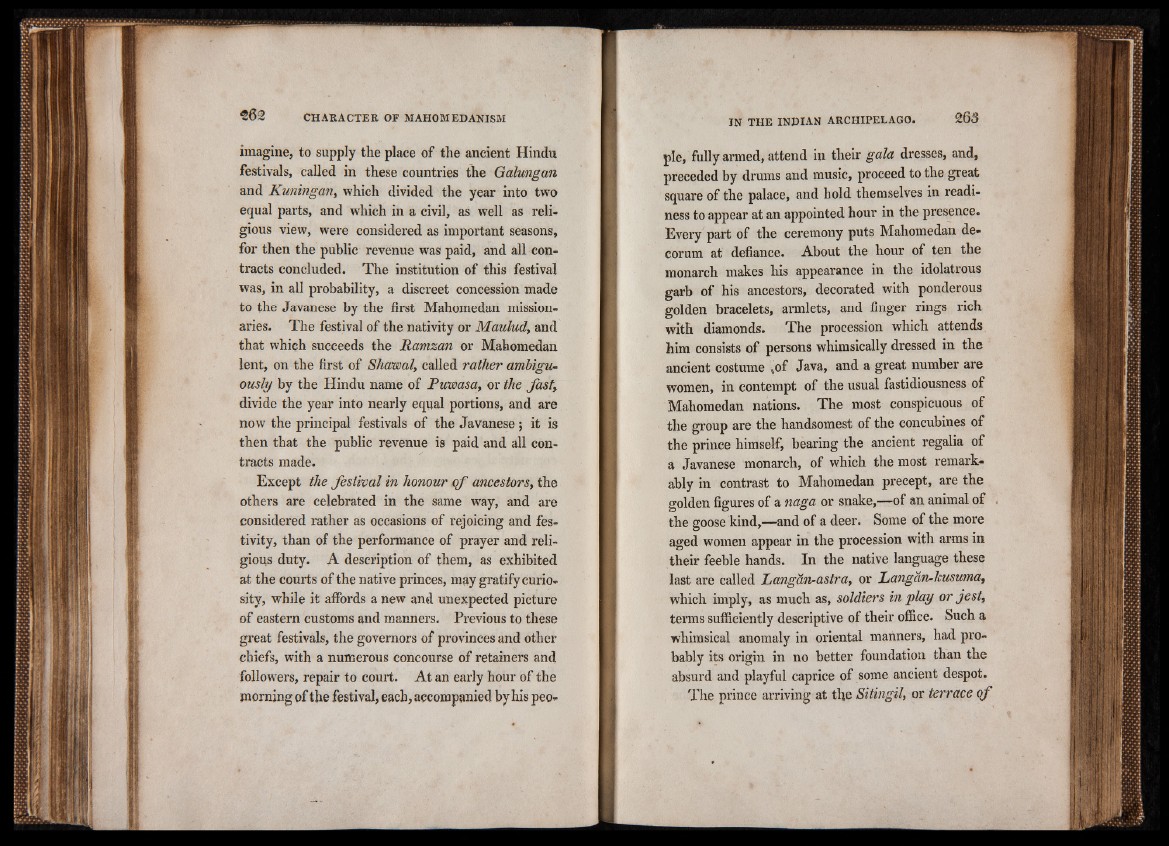
imagine, to supply the place of the ancient Hindu
festivals, called in these countries the Galungan
and Kuningan, which divided the year into two
equal parts, and which in a civil, as well as religious
view, were considered as important seasons,
for then the public revenue was paid, and all contracts
concluded. The institution of this festival
was, in all probability, a discreet concession made
to the Javanese by the first Mahomedan missionaries.
The festival of the nativity or Maulud, and
that which succeeds the Ramzan or Mahomedan
lent, on the first of Shawal, called rather ambiguously
by the Hindu name of JPwwasa, or the fasty
divide the year into nearly equal portions, and are
now the principal festivals of the Javanese; it is
then that the public revenue is paid and all contracts
made.
Except the festival in honour o f ancestors, the
others are celebrated in the same way, and are
considered rather as occasions of rejoicing and festivity,
than of the performance of prayer and religious
duty. A description of them, as exhibited
at the courts of the native princes, may gratify curiosity,
while it affords a new and unexpected picture
of eastern customs and manners. Previous to these
great festivals, the governors of provinces and other
chiefs, with a numerous concourse of retainers and
followers, repair to court. At an early hour of the
jnorning of the festival, each, accompanied by his peopie,
fully armed, attend in their gala dresses, and,
preceded by drums and music, proceed to the great
square of the palace, and hold themselves in readiness
to appear at an appointed hour in the presence.
Every part of the ceremony puts Mahomedan decorum
at defiance. About the hour of ten the
monarch makes his appearance in the idolatrous
garb of his ancestors, decorated with ponderous
golden bracelets, armlets, and finger rings rich
with diamonds. The procession which attends
him consists of persons whimsically dressed in the
ancient costume ,of Java, and a great number are
women, in contempt of the usual fastidiousness of
Mahomedan nations. The most conspicuous of
the group are the handsomest of the concubines of
the prince himself, bearing the ancient regalia of
a Javanese monarch, of which the most remarkably
in contrast to Mahomedan precept, are the
golden figures of a naga or snake,—of an animal of
the goose kind,—and of a deer. Some of the more
aged women appear in the procession with arms in
their feeble hands. In the native language these
last are called Langan-astra, or Langan-kusumay
which imply, as much as, soldiers in play or jest,
terms sufficiently descriptive of their office. Such a
whimsical anomaly in oriental manners, had probably
its origin in no better foundation than the
absurd and playful caprice of some ancient despot.
The prince arriving at the Sitingil, or terrace of